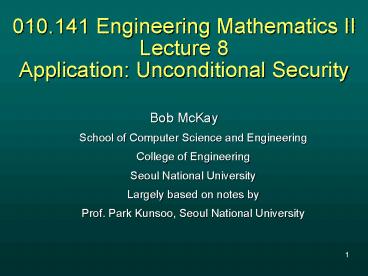010'141 Engineering Mathematics II Lecture 8 Application: Unconditional Security PowerPoint PPT Presentation
1 / 14
Title: 010'141 Engineering Mathematics II Lecture 8 Application: Unconditional Security
1
010.141 Engineering Mathematics IILecture
8Application Unconditional Security
- Bob McKay
- School of Computer Science and Engineering
- College of Engineering
- Seoul National University
- Largely based on notes by
- Prof. Park Kunsoo, Seoul National University
2
Outline
- Unconditional Security
- One-time pads
3
Two Views of Cryptosystem Security
- Computational security
- Measures the computational effort required to
break a cryptosystem - A common approach is to reduce the security of a
cryptosystem to some well-studied problem such as
factoring - Unconditional security
- A cryptosystem is unconditionally secure if it
cannot be broken, even with infinite
computational resources
4
Unconditional Security
- We develop the theory of cryptosystems that are
unconditionally secure against cyphertext-only
attacks - Unconditional security is based on probability
theory
5
Modified Shift Cypher
- Let P C K Z26
- For 0 ? K ? 25, define EK(x) x K mod
26and DK(y) y - K mod 26where x,y ? Z26 - We will use a particular key only for one
encryption - i.e. use n keys to encrypt n plaintexts.
6
Probability Assumptions
- The plaintext M and cyphertext C are random
variables - Let PM(x) PM x and PC(y) PC y
- Assume that there is a prior probability
distribution on the plaintext space P - i.e., PM(x) is the a priori probability that the
plaintext is x - Assume that each key is chosen at random.
- Assume that the key K and the plaintext x are
independent events
7
Induced Probability Distribution
- The two probability distributions on P and K
induce a probability distribution on C - The probability that the cyphertext is y ? C
isPC(y) ?x ? PPM(x) PCM(yx) - Since PCM(yx) PK ? y - x mod 26 1/26
PC(y) 1/26
8
Perfect Secrecy
- A cryptosystem has perfect secrecy
ifPMC(xy)PM(x)? x ? P, y ? C - That is, the a posteriori probability that the
plaintext is x, given that the cyphertext y is
observed, is identical to the a priori
probability that the plaintext is x - Or to put it another way, knowing the cyphertext
doesnt assist you to know the plaintext
9
Shift Cypher Perfect Secrecy
- Theorem
- If the 26 keys in the Shift Cipher are used with
equal probability 1/26, then the Shift Cipher has
perfect secrecy for any plaintext probability
distribution - Proof
- PMC(xy) PM(x) PCM(yx) / PC(y) PM(x)
10
Shift Cypher Perfect Secrecy
- Theorem
- Suppose a cryptosystem satisfies P C
KThen the cryptosystem has perfect secrecy iff
- Every key is used with equal probability
- For every x ? P and every y ? C, there is a
unique key K such that EK(x) y
11
One-Time Pad
- A special case of the Shift Cipher where Zm Z2
- A secret-key cryptosystem where the key is as
long as the message being encrypted - The key, once used, is discarded and never used
again - When A and B wish to communicate, they must have
previously agreed upon a secret key K which is a
string of n randomly chosen bits
12
One-Time Pad Example
- When A wishes to send an n-bit message M to B,
- A sends C M ? K
- B obtains M by M C ? K M 0011 K 0101 C
0110
13
Summary
- Unconditional Security
- One-time pads
14
?????

